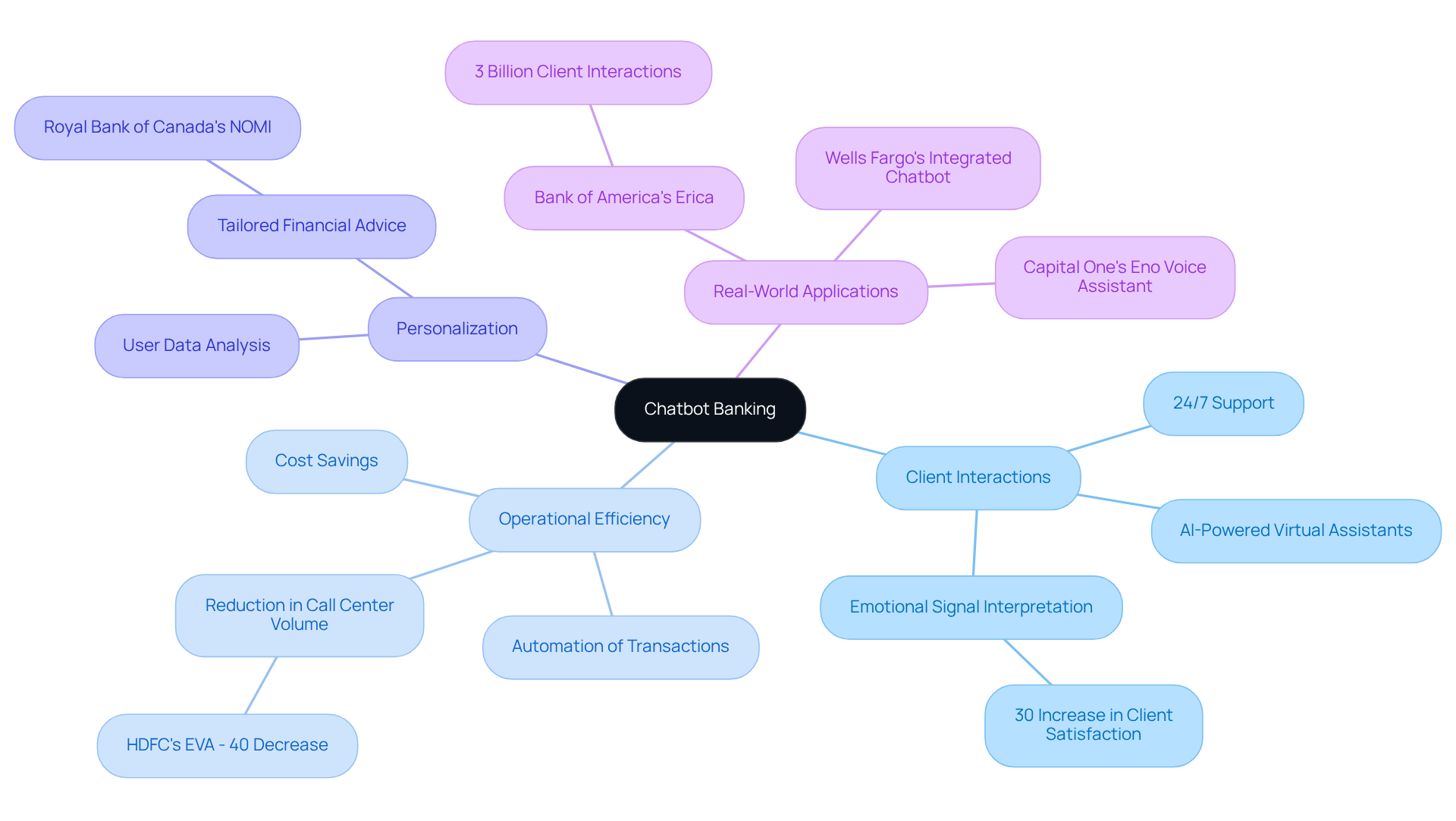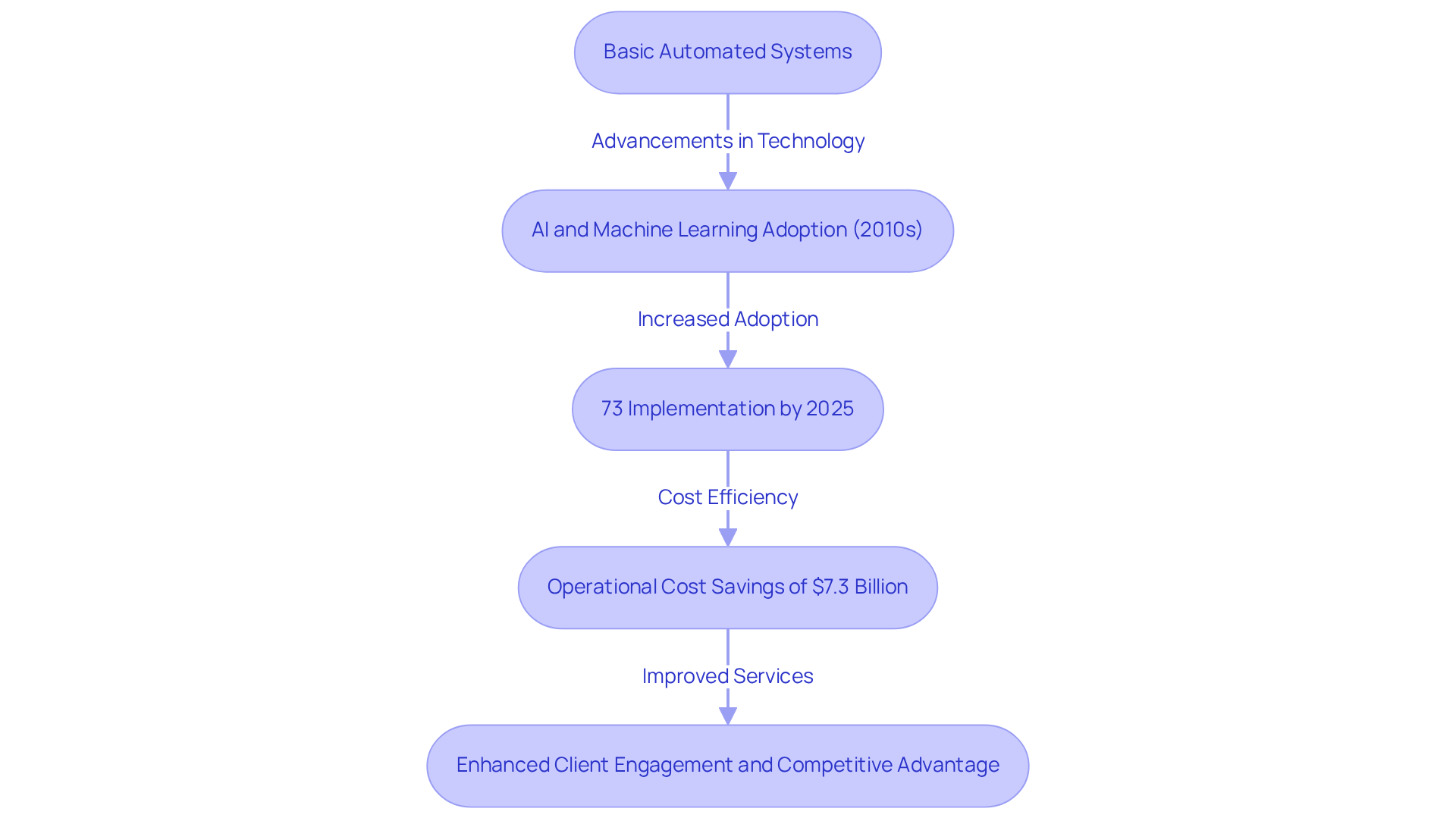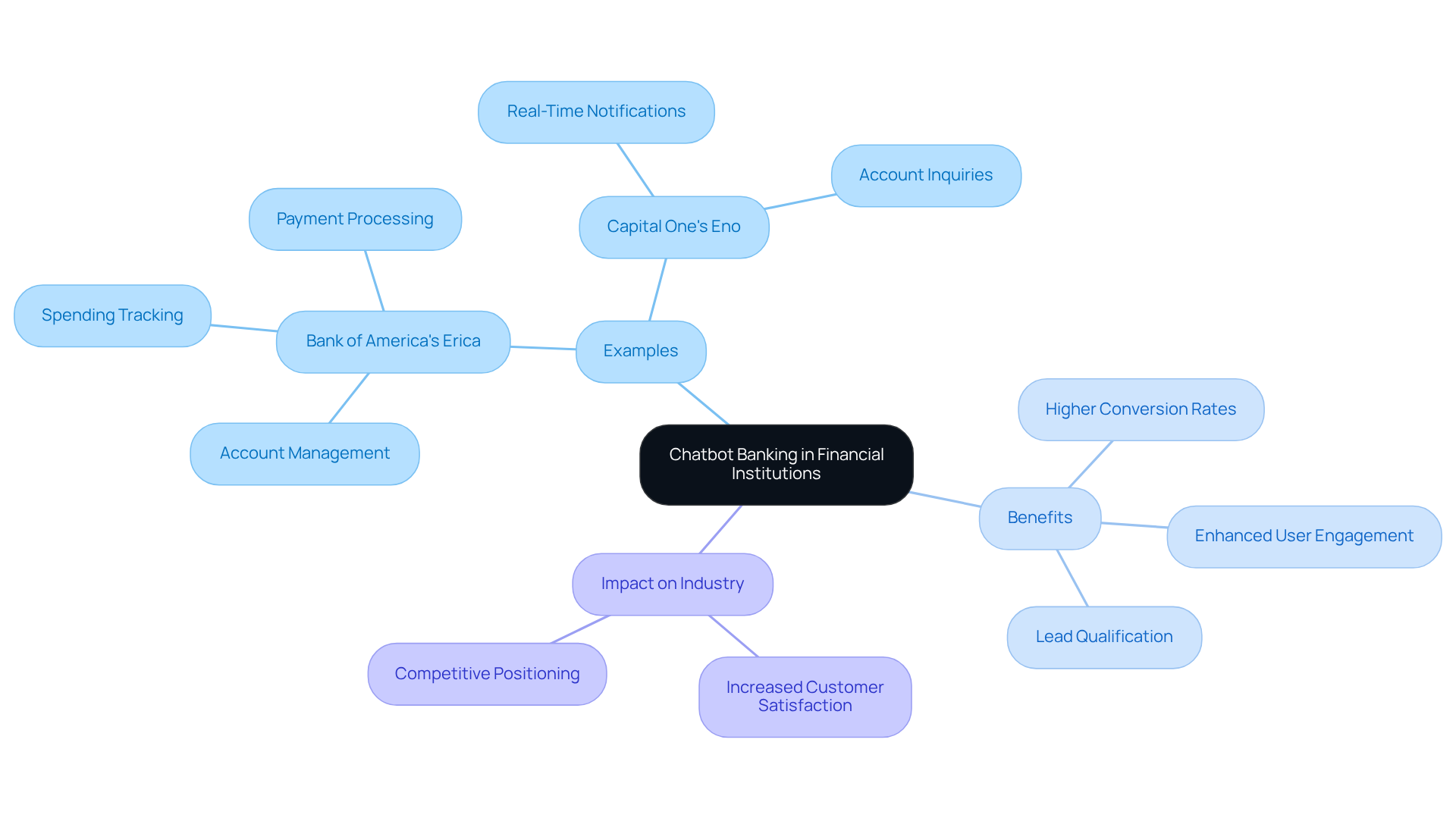Overview
Chatbot banking represents a significant advancement in the financial sector, leveraging AI-powered virtual assistants to enhance customer interactions and automate transactions. This innovative approach provides 24/7 support and personalized services, fundamentally transforming how clients engage with their financial institutions.
The integration of advanced features such as natural language processing, real-time updates, and seamless connectivity with banking systems not only boosts client satisfaction but also enhances operational efficiency. As financial institutions increasingly adopt this technology, they are witnessing a marked improvement in service delivery, which is crucial in today’s fast-paced environment.
Incorporating chatbot banking into operational strategies is not merely a trend; it is a necessity for institutions aiming to remain competitive. The ability to provide immediate responses and tailored assistance positions banks at the forefront of customer service excellence.
In summary, chatbot banking is reshaping the service landscape in finance, offering a compelling solution that meets the evolving needs of customers while driving efficiency for financial institutions.
Introduction
Chatbot banking signifies a transformative shift in the financial services landscape, leveraging AI-driven virtual assistants to enhance customer interactions and streamline operations. This innovative approach not only provides clients with 24/7 support but also significantly improves efficiency by automating routine transactions and inquiries. However, as financial institutions embrace this technology, a critical question arises: can these virtual agents truly meet the nuanced needs of consumers while maintaining trust and satisfaction in an increasingly digital world?
Define Chatbot Banking: An Overview
Chat bot banking signifies a substantial advancement in the financial services industry, utilizing AI-powered virtual assistants to improve client interactions and automate various transactions. These virtual assistants engage with clients through text or voice, assisting with inquiries, executing transactions, and managing account administration. By harnessing natural language processing (NLP) and machine learning, chatbot financial services markedly improve client experience, streamline operations, and alleviate the workload on human agents. This innovative approach not only enhances efficiency but also empowers financial institutions to offer 24/7 support, catering to the needs of tech-savvy consumers who demand immediate responses.
Looking ahead to 2025, the impact of AI conversational agents on client experience in financial services is poised to be substantial. Institutions report a 30% increase in client satisfaction when these agents effectively interpret and respond to emotional signals. For example, Intone's AI-powered voice agents automate tier-1 support, delivering instant replies to FAQs, tracking orders, and addressing account inquiries around the clock. Such service levels cultivate trust and fortify relationships, enabling financial institutions to serve clients proficiently even during peak periods.
Recent innovations in AI conversational agents for financial institutions showcase enhanced personalization features. The Royal Bank of Canada's NOMI virtual assistant, for instance, analyzes personal spending patterns to offer tailored financial advice. Additionally, JPMorgan Chase's hybrid conversational agent system allows clients to choose between AI and human interaction, fostering trust and providing a sense of security.
Real-world applications highlight the effectiveness of AI-driven chat bot banking in the financial sector. Wells Fargo's unified virtual assistant ensures accurate responses and immediate assistance, thereby improving user experience and operational efficiency. Similarly, HDFC Bank's EVA virtual assistant engages website visitors by delivering loan information and addressing product inquiries, transforming passive visits into active client relationships.
In summary, the integration of chat bot banking in financial services, particularly through solutions like Intone's 24/7 AI voice agents, is revolutionizing the service landscape. This transformation renders interactions more efficient and personalized while simultaneously promoting innovation and operational excellence across the sector.

Context and Evolution of Chatbot Banking in Financial Services
The evolution of chat bot banking is intricately linked to the surge of digital banking and the escalating demand for efficient client service solutions. Initially, banks relied on basic automated systems to address client inquiries; however, advancements in technology have significantly enhanced these capabilities. The advent of AI and machine learning in the early 2010s represented a crucial turning point, enabling chatbots to understand and respond to inquiries with improved accuracy and relevance. By 2025, a remarkable 73% of global banks had implemented at least one chat bot banking system in customer-facing operations, highlighting a broader trend towards digital transformation within financial institutions.
This transformation is propelled by the imperative for enhanced client engagement and operational efficiency, as consumers increasingly prefer digital interactions. Notably, banks are anticipated to save around $7.3 billion in operational costs globally through the utilization of chatbots, which manage an estimated 3.1 billion banking interactions each month. Despite these advancements, challenges remain; 80% of consumers reported feeling more frustrated after interacting with an automated assistant, and 39% of banks faced data privacy incidents involving clients.
As the landscape continues to shift, financial institutions are harnessing chat bot banking technology not only to fulfill client expectations but also to secure a competitive advantage in a rapidly evolving market. Intone's AI voice agents exemplify this progression, achieving an impressive 1.5x increase in conversion rates compared to human agents. These agents are designed to automate outbound campaigns for debt collection, loan qualification, and product offers, thereby enhancing sales and client engagement within the fintech sector.
With Intone's real-time voice stack, the setup process is streamlined and efficient, enabling institutions to transition from script to live AI voice agents within days. Furthermore, integrated smart checks prevent hallucinations and ensure compliance during conversations, thereby bolstering the reliability of service delivery. Expert insights underscore the importance of integrating AI into service strategies, with many organizations recognizing that automated responders can enhance service delivery while reducing costs.
This evolution marks a pivotal step in the ongoing digital transformation of the financial sector, positioning chat bot banking as an indispensable tool for future success.

Key Features and Functionalities of Chatbot Banking
Key features of chatbot banking are pivotal in enhancing customer experience and operational efficiency:
-
24/7 Availability: Intone's AI voice agents provide round-the-clock assistance, ensuring customers receive support whenever they need it. This constant availability is essential; studies indicate that 64% of clients appreciate the ability to access assistance outside standard business hours, significantly enhancing satisfaction. With Intone, you can assist clients after hours or during peak times without delays.
-
Advanced Natural Language Processing (NLP) capabilities in chatbot banking empower virtual assistants to understand and respond to customer inquiries in a conversational manner. This technology allows automated systems to manage up to 79% of routine inquiries, decreasing response times for these questions by as much as 80%, thereby enhancing accuracy and user experience.
-
Transaction handling is made easier through chatbot banking, as many virtual assistants facilitate transactions such as fund transfers and bill payments directly through the chat interface. Notably, 23% of users employ automated assistants for bill payments, streamlining banking procedures and enabling clients to accomplish tasks swiftly and effectively.
-
By analyzing client data, chatbot banking can provide personalized recommendations for tailored financial advice and product suggestions. This customization not only boosts user engagement but also cultivates client loyalty by addressing individual needs. Intone's AI voice agents can effectively promote premium plans or new financial products, enhancing sales and customer engagement.
-
Chatbot banking allows for seamless integration with existing banking systems, enabling real-time updates and accurate information delivery. Intone manages the configuration and initiation of your AI sales representative with no effort required from you, enabling banks to employ conversational agents effectively. Banks employing chatbot banking have reported a 41% decrease in ticket backlog rates, illustrating the operational efficiency gained through this integration.
These functionalities not only enhance client satisfaction but also improve operational efficiency. Banks utilizing chatbots have reported significant reductions in average case resolution times and increased productivity across service teams.

Real-World Applications of Chatbot Banking in Financial Institutions
Financial organizations worldwide are progressively utilizing automated banking to enhance client service and optimize operations. A prime example is Bank of America’s Erica, a virtual financial assistant that empowers clients to manage their accounts, track spending, and make payments seamlessly. Similarly, Capital One’s Eno offers real-time transaction notifications and addresses inquiries about accounts, showcasing the versatility of chatbot technology.
These applications not only enhance user engagement but also promote higher conversion rates, as clients benefit from instant assistance and personalized suggestions. Furthermore, chatbots are effectively employed for lead qualification and follow-ups, significantly boosting the efficiency of sales processes within the finance sector.
The success of these implementations underscores how chatbot banking is revolutionizing customer interactions in financial institutions, fostering increased satisfaction and loyalty. By leveraging such technology, financial organizations are not only improving service delivery but also positioning themselves as leaders in an increasingly competitive landscape.

Conclusion
Chat bot banking signifies a transformative shift within the financial services sector, harnessing advanced AI technology to enhance customer interactions and streamline operations. By integrating virtual assistants into banking practices, institutions are not only improving efficiency but also addressing the growing expectations of consumers for immediate and personalized service.
This article explores various facets of chat bot banking, encompassing its:
- Definition
- Evolution
- Key features
- Real-world applications
It underscores the significant advantages these AI-driven solutions offer, including:
- 24/7 availability
- Advanced natural language processing
- Seamless transaction handling
With illustrative examples from leading financial institutions such as Bank of America and JPMorgan Chase, it becomes clear that chat bot banking is not merely a trend but a pivotal element in enhancing customer satisfaction and operational excellence.
As the financial landscape continues to evolve, embracing chat bot banking will be crucial for institutions striving to maintain a competitive edge. The integration of these technologies transcends mere automation; it fosters deeper client relationships and elevates service delivery. Financial organizations are urged to invest in AI-driven solutions, ensuring they are well-prepared to meet the demands of a digital-savvy clientele while paving the way for future innovations in the industry.
Frequently Asked Questions
What is chatbot banking?
Chatbot banking refers to the use of AI-powered virtual assistants in the financial services industry to enhance client interactions and automate transactions. These assistants communicate with clients through text or voice, helping with inquiries, executing transactions, and managing accounts.
How do chatbots improve client experience in banking?
Chatbots improve client experience by utilizing natural language processing (NLP) and machine learning to streamline operations, reduce the workload on human agents, and provide 24/7 support to meet the demands of tech-savvy consumers seeking immediate responses.
What impact is expected from AI conversational agents in financial services by 2025?
By 2025, AI conversational agents are expected to significantly enhance client experience in financial services, with institutions reporting a 30% increase in client satisfaction when these agents effectively interpret and respond to emotional signals.
Can you give examples of AI-powered virtual assistants in banking?
Examples include Intone's AI-powered voice agents that automate tier-1 support for instant replies and account inquiries, and the Royal Bank of Canada's NOMI virtual assistant, which offers personalized financial advice based on spending patterns.
How do hybrid conversational agents work?
Hybrid conversational agents, like those at JPMorgan Chase, allow clients to choose between interacting with AI or a human representative, fostering trust and providing a sense of security.
What are some real-world applications of chatbot banking?
Wells Fargo's unified virtual assistant delivers accurate responses and immediate assistance, while HDFC Bank's EVA virtual assistant engages website visitors by providing loan information and addressing product inquiries, thus enhancing user experience and operational efficiency.
What are the overall benefits of integrating chatbot banking in financial services?
The integration of chatbot banking enhances efficiency and personalization in client interactions, promotes innovation, and improves operational excellence across the financial services sector.






